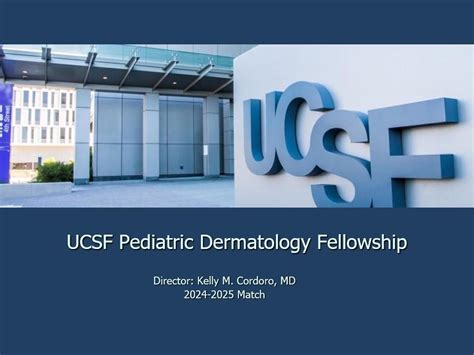Introduction
Pediatric dermatology, a subspecialty of dermatology, focuses on the unique dermatological needs of infants, children, and adolescents. Pediatric dermatologists are trained to diagnose and manage a wide range of skin disorders in the pediatric population, including:

- Eczema (atopic dermatitis)
- Psoriasis
- Acne
- Birthmarks
- Skin infections
- Rashes
- Sunburn
According to the American Academy of Dermatology (AAD), there were approximately 5,000 board-certified dermatologists in the United States in 2022. Of these, only about 5% were pediatric dermatologists.
Fellowship Program Overview
Pediatric dermatology fellowships typically last for 12-24 months and provide advanced training in the diagnosis and management of skin disorders in children. Fellows receive extensive clinical experience in diagnosing and treating a wide range of pediatric dermatological conditions. They also participate in research projects, attend lectures and conferences, and teach medical students and residents.
Eligibility and Application Process
To be eligible for a pediatric dermatology fellowship, applicants must have completed an accredited dermatology residency program. The application process typically involves submitting a curriculum vitae, letters of recommendation, and a personal statement.
Salary and Job Outlook
According to the Medscape Physician Compensation Report 2023, the average salary for pediatric dermatologists in the United States is $305,000. The job outlook for pediatric dermatologists is expected to be excellent in the coming years, as the demand for healthcare services for children continues to grow.
Career Options
Pediatric dermatologists have a variety of career options, including:
- Private practice
- Hospital-based practice
- Academic medicine
- Research
- Public health
Tips for Success
Here are a few tips for maximizing your success in a pediatric dermatology fellowship:
- Be passionate about providing care to children.
- Develop strong clinical skills in diagnosing and managing pediatric skin disorders.
- Get involved in research and publish your findings.
- Seek mentorship from experienced pediatric dermatologists.
- Stay up-to-date on the latest advances in pediatric dermatology.
Table 1: Pediatric Dermatology Fellowship Programs in the United States
| Institution | Location | Duration |
|---|---|---|
| Children’s Hospital of Philadelphia | Philadelphia, PA | 12 months |
| Boston Children’s Hospital | Boston, MA | 24 months |
| Stanford University Medical Center | Stanford, CA | 24 months |
| University of California, San Francisco | San Francisco, CA | 18 months |
| New York University Langone Health | New York, NY | 24 months |
Table 2: Core Curriculum for Pediatric Dermatology Fellowships
| Core Curriculum Area | Sample Topics |
|---|---|
| Clinical Dermatology | Eczema, psoriasis, acne |
| Pediatric Dermatology | Birthmarks, skin infections, rashes |
| Pediatric Surgery | Minor surgical procedures |
| Medical Dermatology | Allergic reactions, skin cancer |
| Research Methods | Study design, data analysis |
| Ethics in Medicine | Informed consent, confidentiality |
Table 3: Pros and Cons of Pediatric Dermatology Fellowships
| Pros | Cons |
|---|---|
| High-quality clinical training | Long hours and demanding workload |
| Variety of career options | Relatively small field |
| Opportunity to make a difference in the lives of children | Limited number of fellowship programs |
Table 4: Step-by-Step Approach to Applying for a Pediatric Dermatology Fellowship
- Research different fellowship programs.
- Contact the program directors and express your interest.
- Submit your application materials.
- Interview with the program directors.
- Make a decision and accept a fellowship position.
Conclusion
A pediatric dermatology fellowship provides advanced training in the diagnosis and management of skin disorders in infants, children, and adolescents. Pediatric dermatologists play a vital role in providing healthcare to children and have a variety of career options. With a strong clinical foundation, a commitment to research, and a passion for working with children, you can build a rewarding and successful career in pediatric dermatology.
